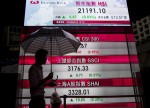
- All Instrument Types
- Indices
- Equities
- ETFs
- Funds
- Commodities
- Currencies
- Crypto
- Bonds
- Certificates
Please try another search

U.S. Dollar Advances Against Most Major And Emerging Market Currencies

The U.S. dollar gained against the major currencies, except for the Swiss franc, which strengthened to its best level against the euro since April 2017. It has risen for six of the past seven weeks, and the week that it fell, it slipped less than 0.1%. The franc's strength could be a sign of fear in the market, but the other so-called safe haven currency, the Japanese yen was the weakest of the majors, falling almost 0.65%.
Similarly, the dollar rose against most emerging market currencies. The Chinese yuan was the second strongest currency (-0.85%) behind the Indonesian rupiah (~0.95%). While the Mexican peso climbed another 0.7%, Brazil's real fell 1.5%, bringing this year's loss to 3.15% and only bested by the South African rand's 3.25% drop, though the latter got a surprises 25 bp rate cut out of it as well.
The S&P 500 and the Dow Jones STOXX 600 rose to new record highs, and the MSCI Emerging Markets Equity Index extended its advancing streak to the seventh consecutive week, the longest rally in a couple of years. A notable exception is the Shanghai Composite, which fell by about 0.5%, the first decline in seven weeks.
Meanwhile, a combination of official comments and dismal data, including a dreadful retail sales report before the weekend, has sparked a shift in Bank of England expectations. A week ago, the market was pricing less than a one-in-four chance and now is nearly a three-out-of-four chance discounted for the Jan. 30 meeting, Carney's last.
Dollar Index: The last two sessions have seen impulsive dollar gains. Thursday, the Dollar Index is at a seven-day low, testing support near 97.00. By the close of business Friday, it was at 97.65, a new high for 2020. The price action looks constructive, and a possible head and shoulders pattern implies potential toward 98.65. The immediate hurdle is the 200-day moving average around 97.70. The MACD is still trending higher, but the Slow Stochastic ascent is slowing.
Euro: Up the stairs, down the elevator, captures the euro's price action. It ground higher until Jan. 16th when it reached almost $1.1175 before reversing lower and fell to nearly $1.1085 by Jan. 17. This corresponds to the neckline of a possible head and shoulders pattern that projects toward $1.0930. Intermittent support is seen near $1.1060 and $1.1020. The MACD is moving lower, while the Slow Stochastic is looking as if it were bottoming. It may take a move now above the $1.1140 area to lift the tone.
Japanese Yen: The dollar made new eight-month highs against the yen (~JPY110.30) ahead of the weekend. On the U.S.-Iran confrontation, the dollar had fallen to JPY107.65 on Jan. 8. Those that got stopped out of long dollar positions, and especially hedges, appeared to scramble to re-establish. However, upticks over the past three sessions have been marginal and hard won. The MACD is getting stretched, and the Slow Stochastic looks poised to cross lower. A break of the five-day moving average (~JPY110.00) would be the first sign the advance is tiring.
Sterling: The shift in rate expectations in the context of an underlying firm dollar tone, saw sterling fall about 0.35%, which understates the bearishness. Ahead of the weekend, it briefly traded at new highs for the week (almost $1.3120) before the shockingly poor retail sales report sent sterling lower, and closed below the previous day's low. The potential key reversal suggests sterling may test the lower end of its recent range (~$1.2900-$1.2950). TThe technical indicators are moving lower. The flash PMI data at the end of next week is expected to show a little improvement. The survey data may not be enough to offset the recent string of poor hard data for policymakers, but the risk-reward shifts against new rate cut bets.
Canadian Dollar: The U.S. dollar has forged a shelf vs the Loonie, around CAD1.3030, and it looks like part of a bullish consolidation pattern. The test is the CAD1.3100 area. A convincing break allows for a move into the CAD1.3140-CAD1.3180, which offers more significant resistance. While in many of the other currency pairs, the MACD and Slow Stochastic are sending different signals, here they agree that the U.S. dollar's upside beckons.
Australian Dollar: The pattern here is familiar. The Australian dollar was resilient in the first part of last week and struggled to make a nine-day high (~$0.6935) before selling off to near $0.6870, ahead of the weekend. Crucial technical support near $0.6850 may be challenged. The MACD has room to fall further, while the Slow Stochastic has already turned.
Mexican Peso: The U.S. dollar fell the most in almost five weeks against the Mexican peso ahead of the weekend. It finished the week on its lows, near MXN18.66, a level not seen since October 2018. Given businesses' and investors' cautious attitude toward the government, high real and nominal rates are demanded. In the current climate, characterized by low volatility and robust risk appetite, the peso continues to benefit from carry-trade strategies. South Africa cutting rates by surprise, and Turkey arguably pushing the key policy rate below inflation, underscores the attractiveness of Mexico. The MXN18.80 area that had offered support may now act as initial resistance. The next important area of chart support is closer to MXN18.50. Declining for six of the past seven weeks, the dollar's technicals remain stretched against the peso. Speculators in the futures market appear to have a record net long peso position.
Chinese Yuan: The dollar fell about 0.85% against the Chinese yuan last week. It was the biggest decline since last February and is the sixth decline in the past eight weeks. The dollar peaked last September near CNY7.1850, and at the end of last week was approaching the CNY6.85, an area not seen since in six months. Chinese officials are not protesting the price action through the usual channels, including the setting of the reference rate. Some yuan demand may be related to the approaching Lunar New Year (Jan. 25). Previously, some argued that the yuan's weakness was meant to offset the U.S. tariffs, which always seemed a stretch. Still, now the risk is that the currency appreciation blunts some of the effects of the easier monetary policy stance and could exacerbate the disinflationary forces that can be detected looking through food prices. A move back above CNY6.90 would suggest a low is in place.
Gold: The price of the yellow metal slipped 0.3% (~$5) last week, which was sufficient to snap a five-week and more than a $150 rally. It recovered from a drop to about $1536 on January 14 to advance in two of the last three sessions to close the week a little above $1557. The MACD warns that the downside correction may not be over, but the Slow Stochastic's decline is moderating. A break of last week's low, which also now corresponds to the 20-day moving average may be a preliminary indication of a new phase in gold.
Oil: After reversing lower (from a panic peak near $65.40) as the U.S.-Iran confrontation subsided, March light sweet crude oil prices approached the 200-day moving average last week near $57. It appears to have found a near-term floor. The disruption of Libyan supplies may offer an upside catalyst at the start of the new week. Both the MACD and Slow Stochastic are turning higher. Initial potential may extend toward $60.30-$60.50.
U.S. Rates: The U.S. 10-year yield was steady, rising less than a basis point last week to poke above 1.82%. It is the highest weekly close of the year, but still lower than at the end of last year (~1.92%). The range (~1.77%-1.86%) was within the range of the previous week (~1.70%-1.90%). The March note futures contract continues to straddle the middle of the 128-130 range. The technical indicators are not generating robust signals but do not appear to suggest an imminent breakout. The 2-year:10-year yield curve had been flattening, from nearly 35 bp at the end of last year to 22 bp in the middle of last week. The Treasury's announcement that a 20-year bond will be added to U.S. issuance spurred a steepening on long-end supply considerations. The curve finished the week at about 26 bp.
S&P 500: The gaps created by the higher openings of the S&P 500 last Thursday and Friday remain unfilled. There is a rule among old commodity traders to sell the third consecutive gap, but as one can imagine, this is a rare occurrence. The pre-weekend gap is found between about 3317.1 and 3318.8. The first gap is roughly 3298.6 to 3302.8. The S&P 500 is in a powerful advance. Since the week ending Oct. 4, when the S&P 500 fell for a third consecutive week, the bull run has been incorrigible: it has rallied every week but two. And in those two weeks, the S&P fell a combined 0.5%. Last week alone it gained almost 2%, the most since the end of August.
Related Articles

USD/CAD lifted by Trump’s tariff push but faces resistance overhead US data missing forecasts at the fastest pace in five months Fed rate cut bets grow, pushing Treasury yields...
The euro has gained ground on Tuesday. In the North American session, EUR/USD is trading at 1.0515, up 0.45%. On Monday, the euro climbed as high as 1.0527, its highest level this...

The German election results initially boosted optimism, but uncertainty over coalition talks is keeping pressure on EUR/USD. Trump's confirmation of tariffs on Mexico and Canada...
Are you sure you want to block %USER_NAME%?
By doing so, you and %USER_NAME% will not be able to see any of each other's Investing.com's posts.
%USER_NAME% was successfully added to your Block List
Since you’ve just unblocked this person, you must wait 48 hours before renewing the block.
I feel that this comment is:
Thank You!
Your report has been sent to our moderators for review





Add a Comment
We encourage you to use comments to engage with other users, share your perspective and ask questions of authors and each other. However, in order to maintain the high level of discourse we’ve all come to value and expect, please keep the following criteria in mind:
Enrich the conversation, don’t trash it.
Stay focused and on track. Only post material that’s relevant to the topic being discussed.
Be respectful. Even negative opinions can be framed positively and diplomatically. Avoid profanity, slander or personal attacks directed at an author or another user. Racism, sexism and other forms of discrimination will not be tolerated.
Perpetrators of spam or abuse will be deleted from the site and prohibited from future registration at Investing.com’s discretion.